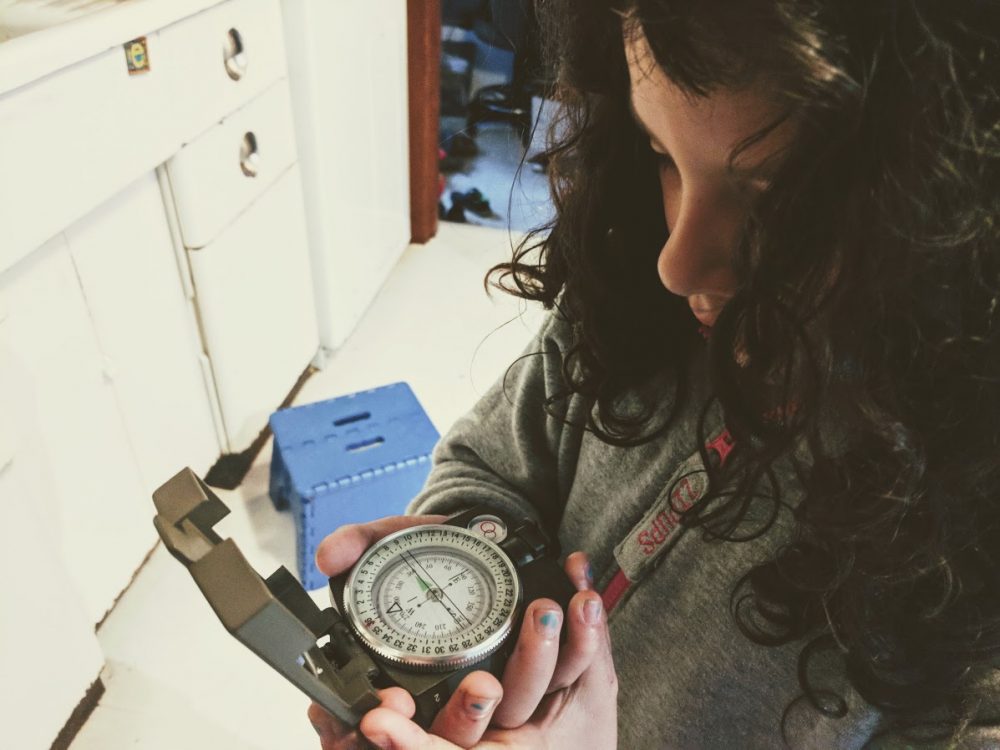Gain real life experience with a compass and vectors as you search for treasure
What you’ll learn:
How vectors add together in any order to reach the same point using a vector treasure map or outdoor orienteering.
Key takeaways:
Vectors have a size (here a distance) and a direction. Vectors are added head to tail and can act as directions.
Two Easter egg hunt ideas to teach vectors.
We’ve come up with two ideas that blend your classic Easter egg hunt with the physics of vectors. Students often learn vectors in high school physics, but with this project, your kids can learn the basics of vectors and vector addition through hands-on play. That means it won’t seem so scary when they reach high school physics!
A vector treasure map to find the Easter basket.
The first Easter egg hunt idea can be done two ways. If you are in a pinch you can just download our vector treasure map that has the treasure map, directions, and vectors that kids can cut out. As they follow the directions and glue the vectors head to tail they will reveal where the Easter basket is hidden in the house. You can either use this as a key to unlock the real location of their Easter basket or place their Easter baskets in the same place in your house (aka, in the dryer).
If you have a bit of extra time you can download our blank vector treasure map grid, draw in the format of your house, and give them directions for them to discover the Easter basket location using vector addition.
A vector treasure hunt to find the Easter basket.
You might be wondering, what is the difference between the vector treasure map and the vector treasure hunt – seems awfully similar. For this Easter egg hunt idea, you will need a few supplies outlined below. Basically, you will teach orienteering skills and vector addition as kids do their Easter egg hunt outside (or I guess you can also do this one inside). Kids will need to measure how far they walk and make sure it is in the right direction to find the next vector to follow.
Whichever Easter egg hunt idea you choose you can find downloads and details below – make sure to share the links with your friends!
Project Ingredients for the hunt:
- Compass
- Walking wheel or measuring tape
- Plastic eggs
- Treasure or your Easter basket
Doing a vector treasure map Easter egg hunt
- Download our vector treasure map. If you want to hide their Easter basket in the same space as the map directs kids to you should hide your basket in the dryer.
- OR download out blank vector treasure map. If you do this you will need to draw in the map of your house and write your own directions for the Easter egg hunt and place the basket in the final position.
- Kids will cut and paste the vectors in order head to tail to reveal the Easter basket location.

How to create an orienteering vector treasure hunt for Easter
1. Plan your hunt.
This is going to be the most time-consuming part. You will need to think about where you want to hide their treasure (or Easter basket), and plan a route that zigs and zags to it. I used brightly colored eggs to signify the location to my girls. The egg had the next vector coordinate in it for them to follow. This meant they only had to get in the vicinity of the egg to be able to find it.

2. Set up your treasure hunt.
You will want to measure the distance your kids need to walk from one egg to the other as well as the direction. I suggest using the same compass and measuring instrument that they will during this process.

Write down the distance and the direction on for each leg of the treasure hunt on a slip of paper, for example, you could direct them to go “ten feet 30 degrees West of North”. You will need to travel to that spot and put a bright Easter egg there with the next direction (twelve feet 40 degrees South of East, for example). Continue doing this for each leg of the trip you want them to follow.
I suggest setting up one hunt for every two kids, that way kids can work in teams where one measures the direction on a compass and the other lays out the measuring device.
For kids that have trouble with reading, you can put a picture of the compass reading along with the “30 degrees West of North” direction.
3. Help your kids through the hunt.
If this is your child’s first time with orienteering or vectors you will want to be close by to help them find directions and make sure they are measuring distances accurately. Think about their age and focus level when planning the number of legs with the treasure hunt – you want them to have fun!


3 thoughts on “Vector Treasure Map: The Ultimate Easter Egg Hunt”
Comments are closed.